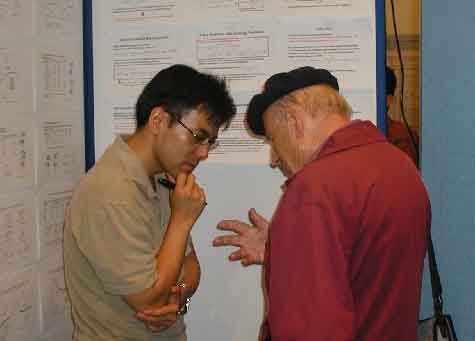Tsuneda Laboratory is working on the development of density functional theory (DFT) especially for theoretical chemistry calculations of large scale molecules with the goal of developing a new-generation theory for chemistry. The achievements of my past studies are classified into two fields:
- Developing exchange-correlation functional and finding the physical meanings, and
- Constructing a new density functional theory for large systems using the long-range correction scheme.
1. Exchange-correlation functional and the physical meanings
Conventional developments of density functionals have focused on the reproducibility of chemical properties using a lot of empirical parameters. The use of parameters essentially leads to the lack of physical meanings in functionals and even produces spurious local minima on potential energy surface. Therefore, we developed new exchange and correlation functionals, in which the number of parameters were reduced to the minimum.
- Tsuneda developed one-parameter progressive (OP) correlation functional. This functional was derived from a correlated wavefunction satisfying correlation cusp conditions by using natural physical approximations. The form of correlation hole was set by using exchange functional and the size of the hole was determined by one parameter. As a result, we confirmed that the OP functional gave accurata electron correlation. Surprisingly, we also found that this functional, which was derived with disregard to physical conditions, is the first correlation functional satisfying all fundamental conditions (J. Chem. Phys., 110, 10664 - 10678, 1999; ibid. 111, 5656 - 5667, 1999).
- Tsuneda also developed parameter-free exchange functional using no empirical parameters. This functional is an exchange energy expression which was derived directly from the density matrix expansion at the Fermi momentum. The most remarkable characteristic of this functional is that the Fermi momentum is determined by using kinetic energy density. Similarly to the OP correlation functional, we found that this exchange functional satisfies all fundamental conditions but the far-nucleus asymptotic condition. We also found that this functional gave accurate exchange energies, despite it contains no parameters (Phys. Rev. B, 62, 15527 - 15531, 2000).
- Based on the above exchange and correlation functionals, Tsuneda clarified a transversing physical connection between fundamental conditions for kinetic, exchange, and correlation energies. It was found that this physical connection is met in the region of near free-electron gas, which exists in the vicinity of chemical bonds (J. Chem. Phys., 114, 6505 - 6513, 2001).
- This transversing connection is violated in the regions where electron-pair interactions are occupied by electron self-interactions. For such regions, there is another relationship based on the self-interaction density matrix. Using this relationship, Tsuneda developed a regional self-interaction correction (RSIC) method. As a result, we found an improvement for several reaction barriers, which have been reported to underestimate (J. Comput. Chem., 24, 1592 - 1598, 2003).
2. Long-range correction scheme and a new density functional theory for large systems calculations
New-generation theory for chemistry is required to reproduce accurate chemical situations of large molecules such as biomolecules. However, it is known that conventional density functional theories have several practical problems even in the calculations of molecules containing a few dozens of atoms. We are investigating this problem by using the long-range correction scheme and so on.
- Tsuneda et al. developed the long-range correction (LC) scheme for exchange functional. Conventional exchange functionals are expressed using one-electron density and therefore contains insufficient long-range exchange interactions. We considered that this may cause various problems in density functional theory. In the LC scheme, two-electron operator is divided by the error function and the short-range part of exchange functional and long-range part of Hartree-Fock exchange integral is combined. We found that the overestimation of the polarizabilities of long-chain polyenes are drastically improved by using the LC scheme (J. Chem. Phys., 115, 3540 - 3544, 2001).
- It has been suggested that van der Waals (vdW) bondings, which play a significant role in the structure of large molecules, are poorly reproduced by conventional density functional theories. Tsuneda, Kamiya, and Sato considered that this problem is originated from the lack of long-range exchange effects in addition to the deficiency of vdW correlations in exchange-correlation functionals, and applied the LC scheme with a vdW correlation functional to the calculations of rare-gas dimers, vdW complexes, benzene and naphthalene dimers. As a result, we succeeded to reproduce accurate vdW bonding in density functional theory calculations (J. Chem. Phys., 117, 6010 - 6015, 2002; ibid. 123, 104307(1-10), 2005; Mol. Phys. (Handy special issue), 103, 1151 - 1164, 2005).
- Time-dependent density functional theory (TDDFT) becomes widely-used as a high-speed and simple method to give accurate excitation energies of molecules. However, it has been reported that conventional TDDFTs underestimate Rydberg excitation energies, oscillator strengths, and charge transfer energies. Tsuneda and Tawada considered that these underestimations may be due to the lack of long-range exchange interactions and applied the LC scheme to TDDFT formulation (LC-TDDFT). As a result of calculations, we found that all these underestimations are drastically improved by using the LC scheme (J. Chem. Phys. 120, 8425 - 8433, 2004).
- Many photochemical reactions of large molecules proceed after long-range charge transfers. However, such long-range charge transfers has been poorly reproduced by conventional TDDFTs as mentioned above, although TDDFT is expected as the best candidate for the excited-state calculation method of large molecules. To approach this problem, Tsuneda and Chiba developed an excited-state molecular dynamics simulation method based on LC-TDDFT. By calculating excited-state geometries and adiabatic excitation energies, it was found that the LC scheme is necessary even to obtain accurate excited-state geometries of small molecules. (J. Chem. Phys., 124, 144106(1-11), 2006).
- Besides of the theories based on the LC scheme, we are developing several algorithms for large systems calculations. The representative example is a state-specific algorithm for high-speed TDDFT calculations by Tsuneda, Yanagisawa, Chiba. This algorithm drastically reduces computational timings by picking up only transitions contributing to the specific excitation by a pertubative selection. As a result of calculations, we succeeded to decrease TDDFT calculation timing dramatically.( J. Theor. Comp. Chem. (APCTCC Special Issue), 4, 265 - 280, 2005.;Chem. Phys. Lett., 420, 391 - 396, 2006.)
3. Implementation of our theories to general quantum chemistry calculation programs
These theories are implemented into several quantum chemistry calculation programs. Especially, density functional theory parts of GAMESS and UTChem programs are based on our program and contain OP correlation functional, LC scheme, and LC-TDDFT . Besides, OP functional is also available in Amsterdam Density Functional (ADF) and Dmol3 programs.
|



